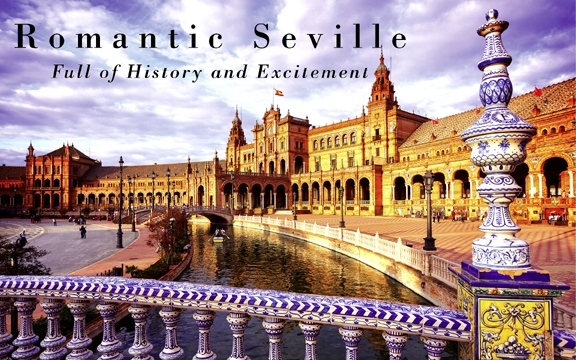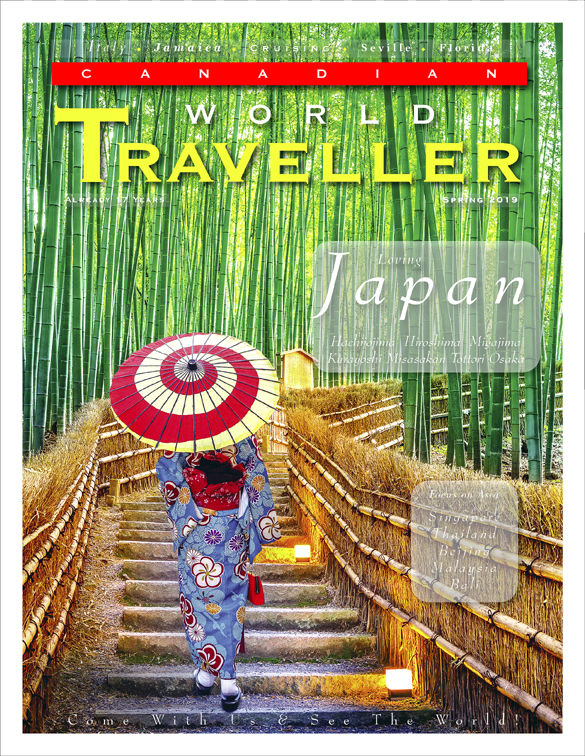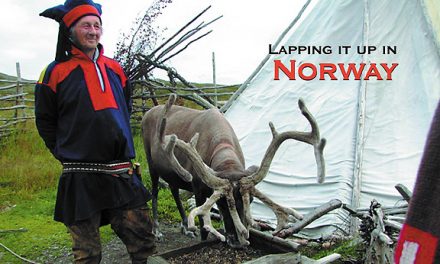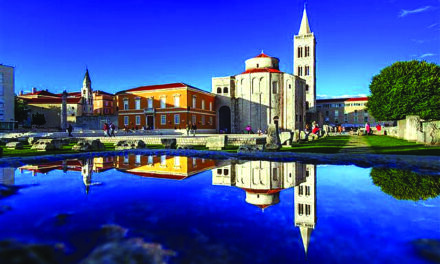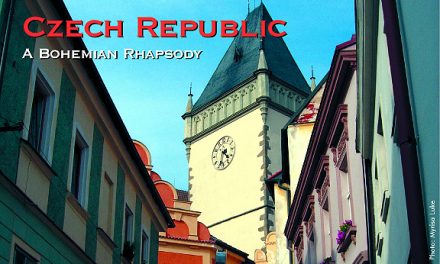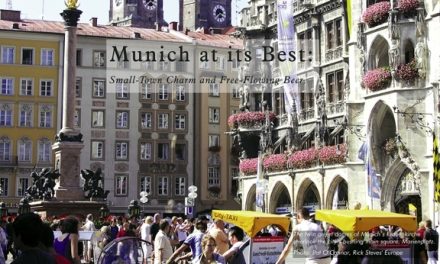Spain
Romantic Seville – Full of History and Excitement
by Habeeb Salloum, M.S.M.

I was exhausted as I laboured up the last few steps of La Giralda – Seville’s most outstanding monument. A steeple of Spain’s most massive cathedral, that is the third largest in the world, it has been for centuries a mecca, drawing countless travellers. For over 770 years, along with other nearby historic structures, it continues to be a lasting reminder of the Moors and their architecture, drawing millions of tourists to Seville.
Struggling up the 97 m (318 ft) high former minaret of the city’s once Great Mosque, it seemed the sky was near before I reached its top. Spent and weary, I clutched the side of the railing and, in the dwindling twilight, surveyed the surrounding panorama.
Below, the Patio de los Naranjos of blossoming orange trees, once the Mosque’s courtyard, along with its other remaining parts now integrated into the Cathedral, were clearly visible. In the distance, on all sides, the vivid colours of the skyline, dotted with the towering steeples of innumerable churches – many former minarets of mosques – created a delightful picture of an oriental town. It seemed that any minute the Moors would appear to make the picture complete.
The oldest and richest of the cities in Andalusia with an aristocratic history, Seville is a coquettish-cosmopolitan metropolis of some 1,500,000 – Spain’s fourth largest city and the capital of Andalusia. Before and during Roman times it was an important urban centre, but it reached its age of splendour under the Moors. They called it ‘Ishbiliya’ (an Arabized form of the Roman Hispalis) and it became a dazzling metropolis and the home of kings, musicians, poets and men of letters.
The Christians recaptured the city in 1248, after which it lost some of its importance for some centuries. However, after the discovery of the Americas, Seville again became important, controlling, for many decades, the trade with the ‘New World’. The wealth this generated made the city one of the richest urban centres on earth and an important commercial and intellectual centre – a position it retains today.
Nevertheless, the illustrious monuments in the older section of town are almost all the legacy of the Moors. From among these, even more imposing than La Giralda, is the edging Alcázar, Seville’s fabulous 14th century Moorish palace built by Mudéjar craftsmen – Muslims living under Christian rule.
The lavishly decorated patio and surrounding chambers incorporate some of the finest examples of Spanish Muslim art, reminding the visitor of Granada’s famous Alhambra. On the outside, its vast well-groomed Moorish-style gardens of shrubs and climbing plants overflow with a profusion of jasmine, lemon, myrtle and orange flowers, giving the palace a ‘Thousand- and One-Nights’ setting.
Next door to this exquisite reminder from the Moorish age is the Barrio de Santa Cruz – after the Reconquista, becoming the Jewish Quarter. The most intriguing part of the city, it consists of a tangled mosaic of narrow streets and cobbled alleyways. Charming whitewashed homes, secluded plazas filled with orange trees, comfortable bars and fine restaurants, cover every inch of the Barrio. Usually the visitor’s first stop, it is a delightful section of town in which one can glory in the city’s Moorish past.
From this Moorish section, it is only a short distance to the imposing Plaza del España with its twin spires dominating the skyline and the nearby María Luisa Park – a large expanse of manicured greenery. Full of flowers, tiled pools and fountains set amid towering trees, this park has, in the main, been responsible for the labelling of Seville as ‘City of Gardens’.
Hidden amid the park’s colours are the Archaeological Museum, housing an impressive collection of pre-Roman and Roman treasures; and the nearby Museum of Arts and Popular Traditions, located in a splendid Mudéjar pavilion – two places not to be missed, especially by first-time visitors.
If travellers have time to spare, there are countless other sites they can explore. From among these are the twelve-sided Torre de Oro, once a part of the Moorish fortification and now a Naval Museum;Pilate’s House, an outstanding example of Mudéjar architecture; and dozens of other historic palaces and churches.
For many, overshadowing all these tourist spots are the colourful fairs and festivals making the city a tourist delight. Commencing on Palm Sunday and continuing until Good Friday, the Holy Week is celebrated by never-ending processions of endless floats carrying jewel-adorned and garlanded statues of the Virgin followed by bands and members of over 100 brotherhoods dressed in their eerie slit-eyed conical hats and black robes. Day and night, the heart-rending cries of saetas (songs of sorrow) echo throughout the city while improvised flamenco by Sevillanos burst on the scene accompanying these lamentations.
Shortly after Holy Week comes the six-day April Fair held in a vast canvas town. Hundreds of kiosks and pavilions, decorated with flags, flowers and lanterns, at night brightly illuminated, give the tent-fairground a seductive air. Amid this colour are held picturesque parades featuring magnificent stallions mounted by couples dressed in traditional Andalusian finery.
During the festivities, the foremost bullfights, highlighted by the top matadors of the season, are held. In every part of the city, from early evening until the wee hours of the morning, dancing, feasting, fireworks displays, music, singing and innumerable other types of merry-making make it an exciting week in which to be in Seville. The saying ‘Oh to be in Seville that April’s here’ is not based upon fiction.
To understand the passion of Spain’s proud cultural heritage is to spend an evening in Seville’s Los Gallos, the city’s oldest and most outstanding flamenco venue located in Plaza de Santa Cruz where one can experience the pulse of Andalusian-Spanish folklore. The 90-minute performances include a total of 10 singers, dancers, and guitarists whose exceptional talents leave the audience mesmerized. The voices of the male singers seem to hypnotize the audience into a state of ecstasy while their emotional songs of love inspire the fiery black-haired women dancers as they stamp the stage floor with wild uncontrolled passion and rhythmic hand-claps. Beautifully costumed, their tight-¬bodied multi-coloured dresses, flaring at the hips and covering petticoats with countless ruffles, match the carnations in their hair. Turning, twisting and leaping up in a provocative fashion, they stir the audience’s inner emotions.
Like purebred Arabian horses, sparks fly from their eyes as they hold their heads high. Now coy, now inviting, they snap and click their fingers as they twirl their erect bodies to the strains of the captivating music.
So much to see and experience but there is another side to Seville’s signature lifestyle, a throw-back to its intermingling of cultures throughout the city’s long history. Tapas bars, some say just over 3,000 of them, proliferate the most exciting of which are located in the old part of Seville along the cobbled streets of Santa Cruz. With the neighbourhood’s narrow streets forming a labyrinth of exciting nooks and crannies, tapas bars are within footsteps of each other. Seville’s tapas bar culture is the best by far in Spain. Chickpeas with spinach, stir-fried delicate liver pieces, cold tomato soup, croquettes, fried fish are just a few examples of must-tries in the city.
Year after year, masses of people come from all parts of Spain and beyond to join in the revelry. Hence, it is very important for visitors to make hotel reservations long before the events take place.
The excitement, drama and delights of Seville, especially during its fairs and festivals, have inspired a good number of novels and plays. The most popular drama in Spanish literature Don Juan Tenorio’s novel and opera ‘Carmen’, and the ‘Barber of Seville’, all have some connection to that city.
They have given it a world-wide reputation as a place of dark-haired beauties, flowers, splendid processions, light-hearted gaiety and the halo of enchanted patios – all not figments of their authors’ imaginations, but attributes of everyday Seville, much of which comes by way of the Moors.
www.spain.info/en
Click on cover to view published article

